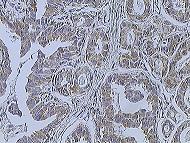An integrated single genomic test would reveal ER and HER-2 status of breast cancer
Feb 15, 2007 - 2:39:19 AM
, Reviewed by: Dr. Rashmi Yadav
|
|
|
"This is one important step towards personalized diagnosis and treatment planning based on an integrated genomic test of an individual tumor."
|
|
Key Points of this article
|
|
About 70 percent of breast cancers are estrogen-receptor positive and another 15 to 25 percent are human epidermal growth factor receptor-2 (HER-2) positive.
|
|
The gene expression tests were 90 percent accurate for both receptors.
|
|
|
|
By University of Texas M. D. Anderson Cancer Center,
[RxPG]
 |
| An integrated single genomic test could estimate the risk of cancer relapse after surgery, determine the ER and HER2 receptor status, and also gauge the sensitivity of the tumor to hormone therapy and chemotherapy. |
Two critical characteristics of breast cancer that are important to treatment can be identified by measuring gene expression in the tumor, a research team led by scientists at The University of Texas M. D. Anderson Cancer Center reports in Lancet Oncology online.
Researchers developed and validated a new genomic microarray test that identifies whether a tumor's growth is fueled by the female hormone estrogen and the role of a growth factor receptor known as HER-2 that makes a tumor vulnerable to a specific drug. The status of these factors is now determined by pathology tests.
"This is one important step towards personalized diagnosis and treatment planning based on an integrated genomic test of an individual tumor," said senior author W. Fraser Symmans, M.D., associate professor in the M. D. Anderson Department of Pathology. The Lancet Oncology paper results are the latest in an effort by the research team to develop a single test to quickly and efficiently determine the characteristics and vulnerabilities of a patient's breast cancer and ultimately to guide treatment.
About 70 percent of breast cancers are estrogen-receptor positive and another 15 to 25 percent are human epidermal growth factor receptor-2 (HER-2) positive. Each receptor status requires different types of treatment.
The gene expression tests were 90 percent accurate for both receptors, which makes them comparable to, if not better than, existing pathology tests.
"This moves us closer to developing an integrated single genomic test that could estimate the risk of cancer relapse after surgery, determine the ER and HER2 receptor status, and also gauge the sensitivity of the tumor to hormone therapy and chemotherapy," says Lajos Pusztai, M.D., Ph.D., associate professor in the M. D. Anderson Department of Breast Medical Oncology, and team leader with Symmans.
ER-positive tumors are treated with estrogen-suppressing drugs such as Tamoxifen. Tumors that are HER-2 positive are sensitive to Herceptin, an antibody-based drug that binds to the HER-2 receptors, blocking them from coupling with growth factors that fuel breast cancer.
Last fall, the group published a study showing that a genomic microarray test can also predict a patient's response to chemotherapy. They also presented a paper in December showing that another genomic index predicts how an ER-positive patient will respond to hormonal therapy.
A prospective clinical trial will soon open at M. D. Anderson to use these tests to recommend treatment for patients with newly diagnosed stage I-III breast cancer.
In the Lancet Oncology paper, they employed an Affymetrix microarray to gather estrogen receptor and HER-2 receptor gene expression data from 495 breast cancer samples from seven institutions. The samples included both fine needle aspiration biopsies and traditional biopsies.
The team used 195 fine-needle biopsy samples to set gene expression thresholds that predicted ER-positive status with 90 percent accuracy and HER-2-positive status with 93 percent accuracy. They then applied those thresholds to two more validation studies involving the remaining samples, which showed that the initial results were both reliable and reproducible.
The gene expression tests disagreed with traditional immunohistochemical lab analysis of the tumors by 8 percent for ER and 11 percent for HER-2. The researchers note this degree of discrepancy is usual when different diagnostic methods are applied to the same samples.
Advertise in this space for $10 per month.
Contact us today.
|
 |
|
Subscribe to Breast Cancer Newsletter
|
|
|
|
About Dr. Rashmi Yadav
|
This news story has been reviewed by Dr. Rashmi Yadav before its publication on RxPG News website. Dr. Rashmi Yadav, MBBS, is a senior editor for RxPG News. In her position she is responsible for managing special correspondents and the surgery section of the website. Her areas of special interest include cardiothoracic surgery and interventional radiology.
RxPG News is committed to promotion and implementation of Evidence Based Medical Journalism in all channels of mass media including internet.
|
|
Additional information about the news article
|
The study was funded by the National Cancer Institute, the Breast Cancer Research Foundation and the Goodwin Foundation.
Co-authors with Symmans and Pusztai are: first author Yun Gong, M.D., and Nour Sneige, M.D., of the M. D. Anderson Department of Pathology; Kai Yan, Keith Anderson, and Kenneth Hess, of the M. D. Anderson Department of Biostatistics; Feng Lin, M.D., Vicente Valero, M.D., Daniel Booser, M.D., Jaime Mejia, M.D., and Gabriel Hortobagyi, M.D., of the M. D. Anderson Department of Breast Medical Oncology; Christos Sotiriou, M.D., Ph.D., Institut Jules Bordet, Brussels, Belgium; Fabrice Andre, M.D., of Institut Gustave Roussy, Villejuif, France; Frankie Holmes, M.D., John Pippen Jr., M.D., and Svetislava Vukelja, M.D., of U.S. Oncology-Texas Oncology; Henry Gomez, M.D., of the Instituto Nacional de Enfermedades Neoplasicas, Lima, Peru; and Luis Barajas, M.D., Departmento de Ginecologia Oncologica, Instituto Mexicano del Seguro Social, Guadalajara, Mexico.
|
|
Feedback
|
For any corrections of factual information, to contact the editors or to send
any medical news or health news press releases, use
feedback form
|
Top of Page
|



